In John Kindness’s visual retelling of the Odyssey, the drowned sailors of Odysseus are shown as starfish-shaped torsos, tattooed and clad in saucy Speedos. We see fragments of the comics, guitars and album covers belonging to the questing hero’s teenage son, Telemachus. Circe, the enchantress who beguiled Odysseus into remaining with her for a year, after turning more of his hapless sailors into pigs, is represented by a pair of painted cotton drawers, the all-encompassing undergarments favoured by men in the 1800s.
Arrayed through the main gallery at the Royal Hibernian Academy, in Dublin, Kindness’s exploration of the 10-year wanderings of Odysseus show in fresco, sculpture, painting, ceramic, enamel, print, mosaic and engraving the Greek king’s attempts to get home after the trials of the Trojan War. Everything pops with colour and sings with ideas. There are aprons, metal panels, a pair of jeans and a set of clothes pegs standing in for sailors. The goddess Athena wears a kettle on her head.
The overall tone is witty and wry, the references eclectic: Scylla and Charybdis, representatives of the original impossible choice between two evils, is a diptych of delicate engravings on a toilet seat and its lid. How better to represent the threat of succumbing to either sea monster or whirlpool? For those not familiar with the minutiae of Homer’s epic, Odysseus opted for Scylla, whose six heads would snap up the same number of sailors, rather than the whirlpool that threatened to take everyone.
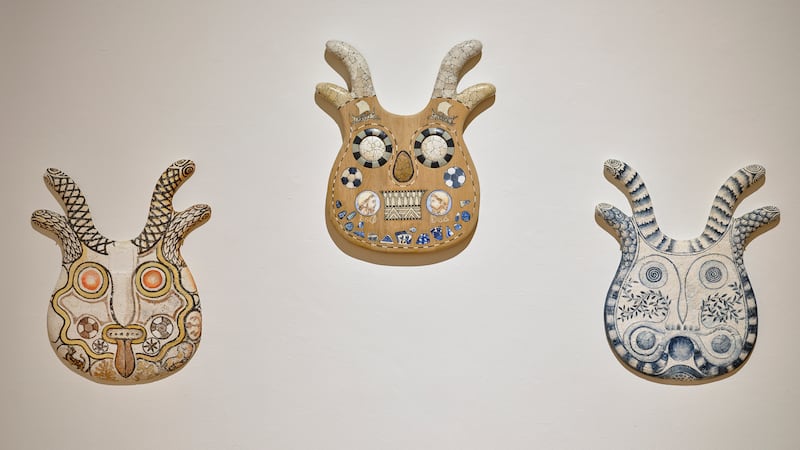
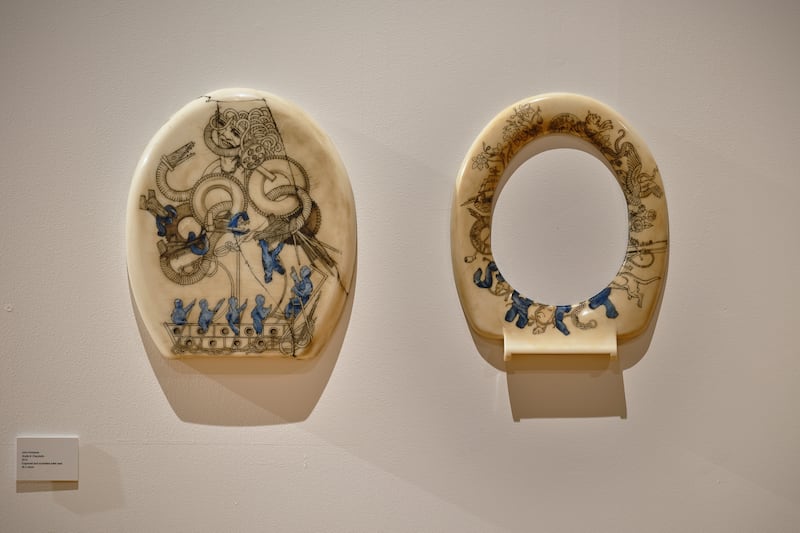
Born in Belfast in 1951, Kindness was one of a group of artists who came to prominence during the Troubles. He featured in a landmark exhibition, Directions Out, at the Douglas Hyde Gallery in 1987, alongside Willie Doherty, Locky Morris, Dermot Seymour, Rita Duffy, Victor Sloan and Una Walker, among others. Kindness created a new painting on site: Night Canvas, in which a man is shot on his doorstep by a masked gunman. His breastfeeding partner, or wife, screams in the background. Their livingroom wallpaper features appliqued ovals of Gerry Adams and Ian Paisley snr above a floral patterned carpet.
RM Block
Following the official cessation of violence in the North, some publicly wondered what these “Troubles artists” would do, a question that overlooks the fact that artists create works that may be connected to their immediate source but can transcend it entirely, to acquire a universal nature. In 1991, his Treasures of New York, at the Kerlin Gallery in Dublin, showed scenes of city life in the style of classical Greek painting, on parts of yellow taxis and metal rubbish bins, an early foray into the world that Kindness would fully inhabit with The Odyssey.
Writing about the New York work in the catalogue for this exhibition, Aidan Dunne describes how Kindness “picked up on the way classical grandeur is invoked to imply civic virtue and eclipse or disguise less savoury aspects of a shabby present”. It is an observation that remains incredibly apt for some current political orations. But beyond this, and Kindness’s evident demonstration of his mastery of many media, what exactly is he up to? “It was James Joyce that led me to Homer,” the artist has said. “And it was his version of the Odyssey” — Ulysses — “that gave me the inspiration for a format in which to tackle it. Joyce ignored nothing; every written scrap, from shopping list to Shakespeare, was brought into his writing and made relevant to his bigger picture.”
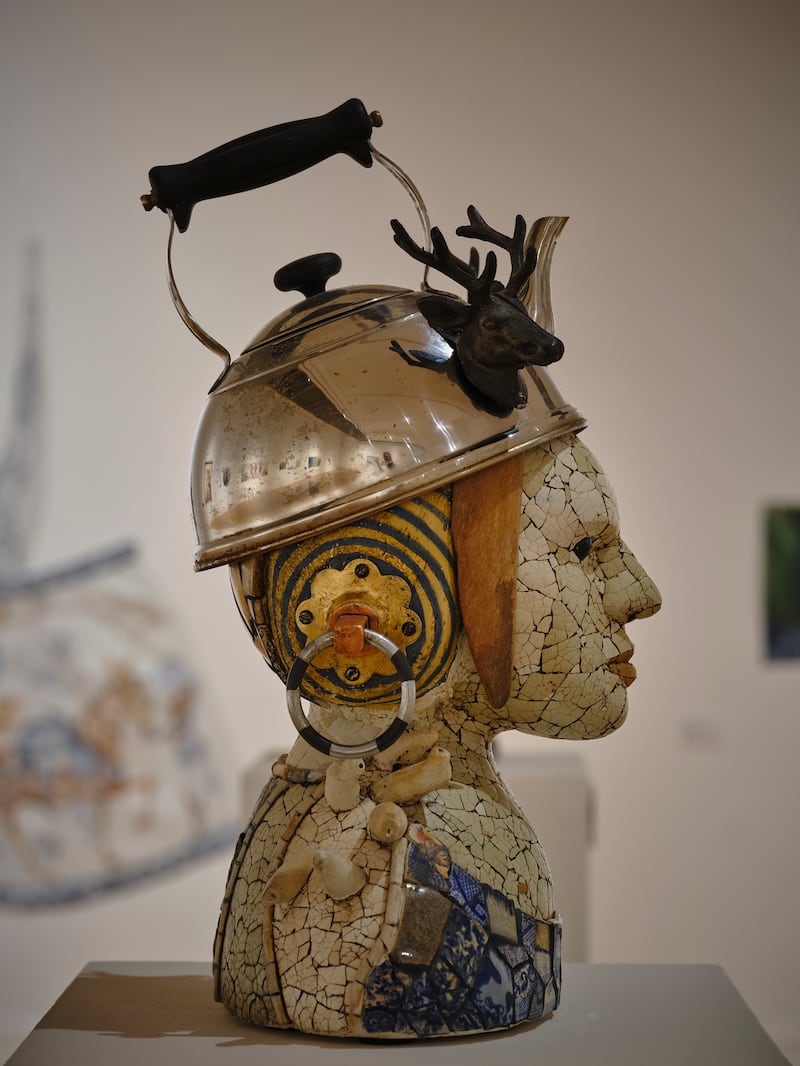
The classical-style Penelope and Telemachus, in gouache on paper, shows just how good a painter Kindness is, as does his oil-on-linen Death of the Suitors, in which Odysseus’s soldiers are brawny blokes, their Grecian drapery somewhat undermined by a hint of string vest. The suitors are depicted as humanoid cuts of meat, their hair a whirl of sausages, with kebab skewers protruding. The longer you give it, the more there is. The linen itself is made from a mangle cloth, and mangling is an apt term for the carnage being meted out on the men Odysseus found lingering around his wife after his 20-year absence. Beneath their brawn, the soldiers are shown to be made of wood. And those meaty victims? All sinew and flesh, they are animals to the slaughter, their ripped clothes like butcher’s wrappings. It is a devastating metaphor for the dehumanising nature of war.
School can make you think that art and writing have to be difficult to be good. Take it from Shakespeare, insight doesn’t come easy. But, as we later realise, Shakespeare had mass appeal in his day, and a great many of the classics are classic because, centuries ago, they struck a chord with a public that wasn’t overly concerned with critical theory but definitely had strong opinions about what they liked.
That’s the story with Homer: the author of the Iliad and the Odyssey was writing in the eighth century BC, when tales across the generations were shared through spoken word or in song. Start writing things down and not only do you lay yourself open to criticism but your work gets preserved, to be discussed, analysed. That can be useful, but it can also come between us and the immediacy of an artwork or text. And there is something in the Odyssey that is so immensely immediate that it has influenced artists and writers right through the intervening centuries.
For one thing, it has all the ingredients of a damn good yarn. In the 1920s the Soviet folklorist Vladimir Propp analysed folk tales and concluded that there are just 31 things that happen, and they unfold in the same general order: the hero leaves the security of home; after doing something forbidden, there is trickery, complicity, villainy, struggle, rescue and transfiguration, and it mostly ends in a wedding. In 1949 the American writer Joseph Campbell, in The Hero With a Thousand Faces, boiled it down to just one, the monomyth: hero leaves home, encounters “fabulous forces”, ultimately triumphs, and comes home enhanced by his adventures.
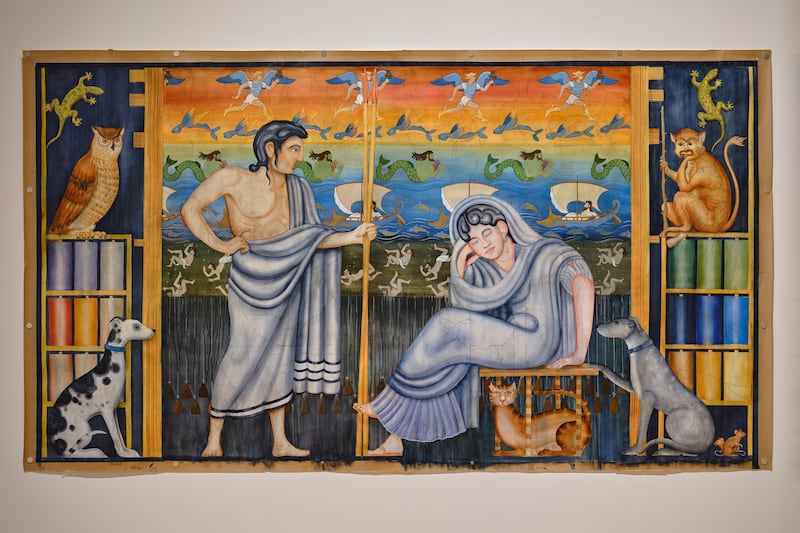
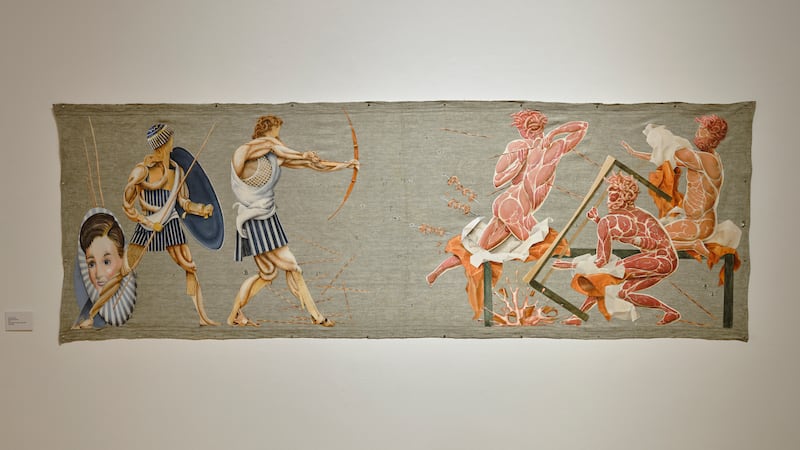
George Lucas credited the idea of the monomyth as an influence on Star Wars; Stanley Kubrick said the same about 2001: A Space Odyssey. And it’s all there in Homer. What Kindness does so brilliantly in this exhibition is to take it all in and then put it back out in the world in a set of contexts that show us how, although mythic figures may enact their roles on vast stages, they are still, at their core, just people doing stuff. Their challenges may be in a different register, but the ethical and moral questions they face are the same as the ones that rise to meet us throughout our lives.
We don’t live our lives in a story, of course, but we default to using stories to understand the events of our lives. Most stories, whether high culture or (if such a thing exists) low, are simply the stories of people. Flawed people, great people, fragile people, people with extraordinary qualities, and sometimes people with deities for friends. We can use this idea to reduce the use of grandeur as a facade. The story may be endlessly repeating, but surely that’s a compelling reason to do better. There is no point in venerating the past unless we are prepared to learn from it.
John Kindness: The Odyssey is at the Royal Hibernian Academy, Dublin 2, until Sunday, February 18th
Inspired by the Odyssey
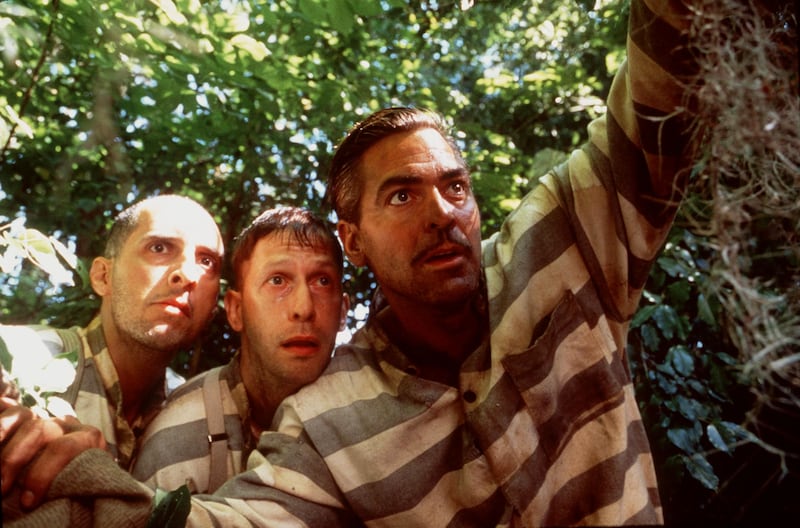
The Trojan War was immortalised by Homer in the Iliad and the Odyssey. With gods and heroes, and beauty enough to launch a thousand ships, it has bravery, trickery, hope, despair and a very large wooden horse. No wonder there have been embroiderings aplenty.
James Joyce: Ulysses (1922) Leopold Bloom’s Dublin may seem a world away from Odysseus’s epic quest, but each part of Joyce’s masterpiece directly connects to Homer’s text, demonstrating the quieter heroics of simply getting through the day.
Joel and Ethan Coen: O Brother, Where Art Thou? (2000) It’s got Cyclops and singing sirens ... The Coen brothers say they hadn’t read the original, but their film takes George Clooney through many of Homer’s plot points on his way back to being reunited with his wife.
Margaret Atwood: The Penelopiad (2005) Shifting the perspective, Atwood has the now long-dead Penelope muse on the events of the Odyssey and wonder why it is so flawed a man should be so well remembered.
Enda Walsh: Penelope (2010) Commissioned for Project Odyssey, the play follows four of Penelope’s suitors, trapped in their inamorata’s swimming pool, vying for her attention in the face of the imminent return of her husband.
Madeline Miller: Circe (2018) It’s the enchantress’s turn to tell the tale in Miller’s award-winning story, which lends even more humanity to the ways of the otherworldly.
Emily Wilson: The Odyssey (2018) Not simply inspired by the Odyssey: as the first woman to translate Homer’s epic, Wilson gave new insights into the story of “a complicated man”. Like that award-winner, her recently published Iliad has been garnering accolades around the world.





















